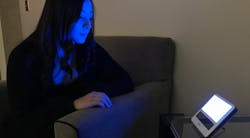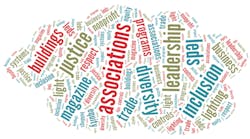In the journal Neurobiology of Disease, a team of scientists from the University of Arizona’s Department of Psychiatry has published findings that indicate circadian entrainment via blue-light emitting devices can advance recovery from mTBI by improving sleep, thus allowing the brain to repair itself more efficiently.
Professor and lead study author William D. “Scott” Killgore said mTBI can have a number of causes, from motor vehicle accidents to sports impact to explosions experienced by military or first-responder personnel. “Your brain is about the consistency of thick Jell-O,” he said. “Imagine a bowl of Jell-O getting hit from a punch or slamming against the steering wheel in a car accident. What’s it doing? It’s absorbing that shock and bouncing around. During that impact, microscopic brain cells thinner than a strand of hair can easily stretch and tear and rip from the force,” he explained in a release from the University of Arizona.
The effects of such brain injuries can include mild disorientation, headaches, difficulty maintaining attention, and mental fogginess that can persist for weeks or months after the inciting event. According to Killgore, “About 50% of people with mTBI also complain that they have sleep problems after an injury.”
Funded by the US Army Medical Research and Development Command, he and co-authors John Vanuk, Bradley Shane, Mareen Weber, and Sahil Bajaj proposed an experiment to determine whether better sleep would improve mTBI healing.
Back in 2016 as LEDs Magazine began to report on the emerging human-centric lighting application, our Mark Halper covered a Danish hospital that was seeing anecdotal improvements in its patients’ recovery from trauma in the intensive care unit. That hospital utilized fully-integrated tunable lighting by Chromaviso in place of standard ceiling troffer lights, and featured ambient programs that would tune between blue-enriched and amber tones throughout the day and evening cycles, but it was not designed as a clinical study per se.
Based on the current science regarding circadian rhythms and the human nonvisual system that controls biological responses to light and melatonin levels, the most restful and restorative sleep would occur during the optimal circadian night cycle, so the team designed its experiment around circadian entrainment on an individual level. As part of a randomized clinical trial, adult participants who experienced mTBI within the past 18 months used an LED lightbox each morning for 30 minutes. Manufactured by Stamford, CT-based Philips Electronics, the lightboxes were fitted either with blue LEDs (469-nm wavelength and 214-lx light dosage for active treatment) in the commercially-available Philips goLITE BLU® Energy Light device, or amber LEDs (578-nm wavelength and 188-lx light dosage for the placebo-controlled group) that were loaned by the manufacturer.
Participants were monitored for sleep and wake activity via wrist-worn actigraph devices and online sleep diaries for a baseline assessment in the week before the study, and continued throughout the 6-week study period in which they were exposed to the blue or amber light therapy daily at home.
Post-assessment, the study authors reported that the blue-light intervention not only improved daytime alertness and sleep quality over the amber placebo light, but it also correlated to increased cognitive performance as a result of the brain repairing itself. Specifically, the researchers reported the brain’s pulvinar nucleus, which is responsible for visual attention, increased in volume in the blue-light group, corresponding to increases in cognition and alertness. Results were measured pre- and post-treatment using MRI scans in addition to cognitive and psychomotor function tests, subjective/objective questionnaires, and more. You can read the full paper at the ScienceDirect website.
Note that the Strategies in Light conference team continues to add expertise on circadian lighting science, solid-state lighting (SSL) product development, and best practices for the industry in its annual program. Read more about the upcoming panels at the 2020 event in a recent LEDs Magazine blog and join us in San Diego Feb. 11–13, 2020.





